Economics Assignment: Cost Analysis and Market Equilibrium Concepts
VerifiedAdded on 2022/10/01
|13
|1762
|306
Homework Assignment
AI Summary
This economics assignment solution covers fundamental concepts including production possibilities, opportunity cost, market equilibrium, and cost analysis. It addresses the concept of increasing opportunity cost using production possibility curves and tables, illustrating resource allocation and efficiency. The solution also explores the impact of technological breakthroughs on market equilibrium, analyzing shifts in supply and demand curves for solar-powered and conventional vehicles. Furthermore, it discusses the ineffectiveness of minimum price policies when set below the equilibrium price. The assignment delves into price elasticity of demand, explaining its variation across seasons and for habit-forming goods. Cost analysis is performed by calculating total variable cost, total cost, average total cost, and marginal cost to determine profit-maximizing output levels for firms. Finally, the solution examines market structures, using the Australian banking industry as an example of a concentrated market dominated by a few major players, which can lead to disadvantages for consumers. Desklib provides access to similar solved assignments and resources for students.
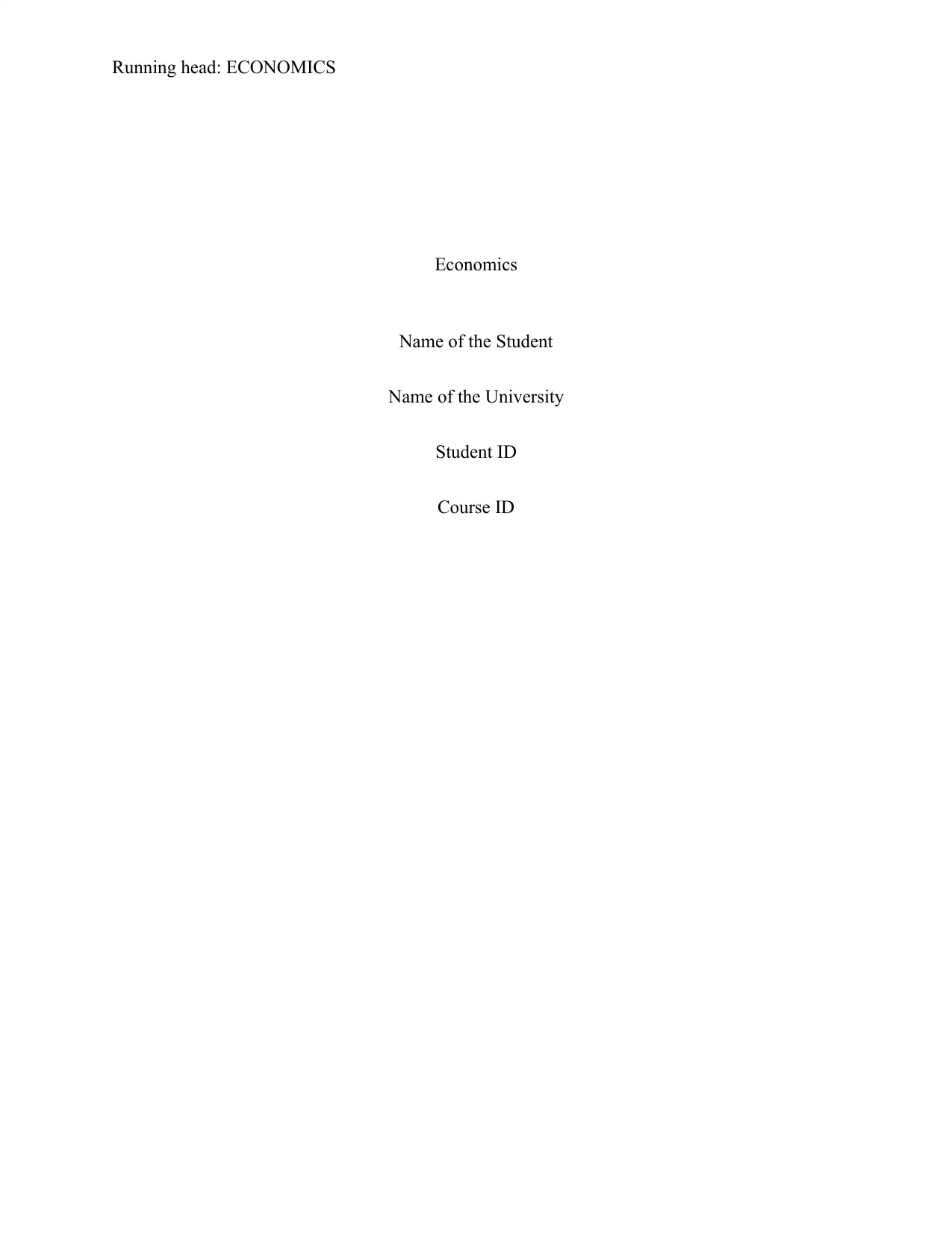
Running head: ECONOMICS
Economics
Name of the Student
Name of the University
Student ID
Course ID
Economics
Name of the Student
Name of the University
Student ID
Course ID
Paraphrase This Document
Need a fresh take? Get an instant paraphrase of this document with our AI Paraphraser
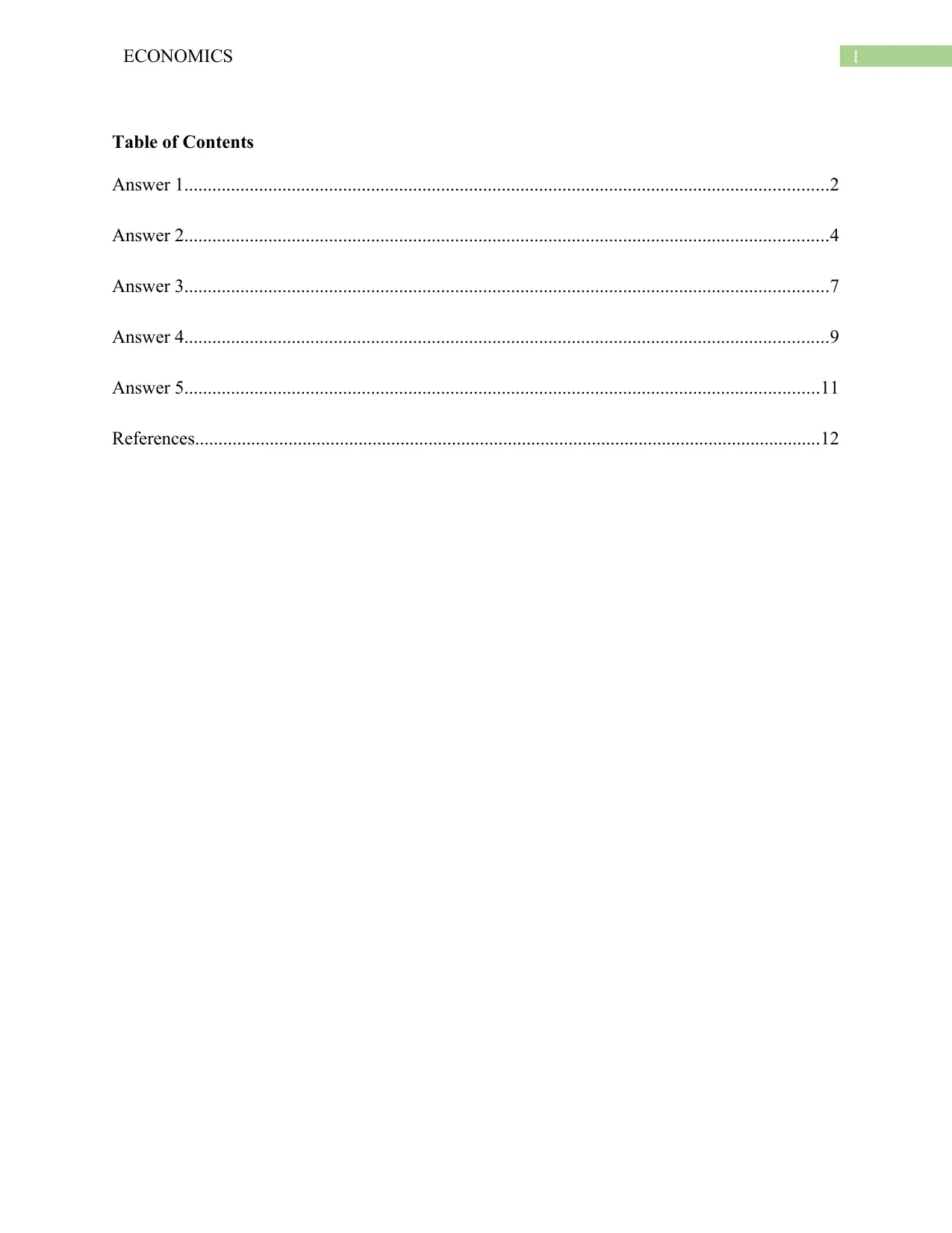
1ECONOMICS
Table of Contents
Answer 1..........................................................................................................................................2
Answer 2..........................................................................................................................................4
Answer 3..........................................................................................................................................7
Answer 4..........................................................................................................................................9
Answer 5........................................................................................................................................11
References......................................................................................................................................12
Table of Contents
Answer 1..........................................................................................................................................2
Answer 2..........................................................................................................................................4
Answer 3..........................................................................................................................................7
Answer 4..........................................................................................................................................9
Answer 5........................................................................................................................................11
References......................................................................................................................................12
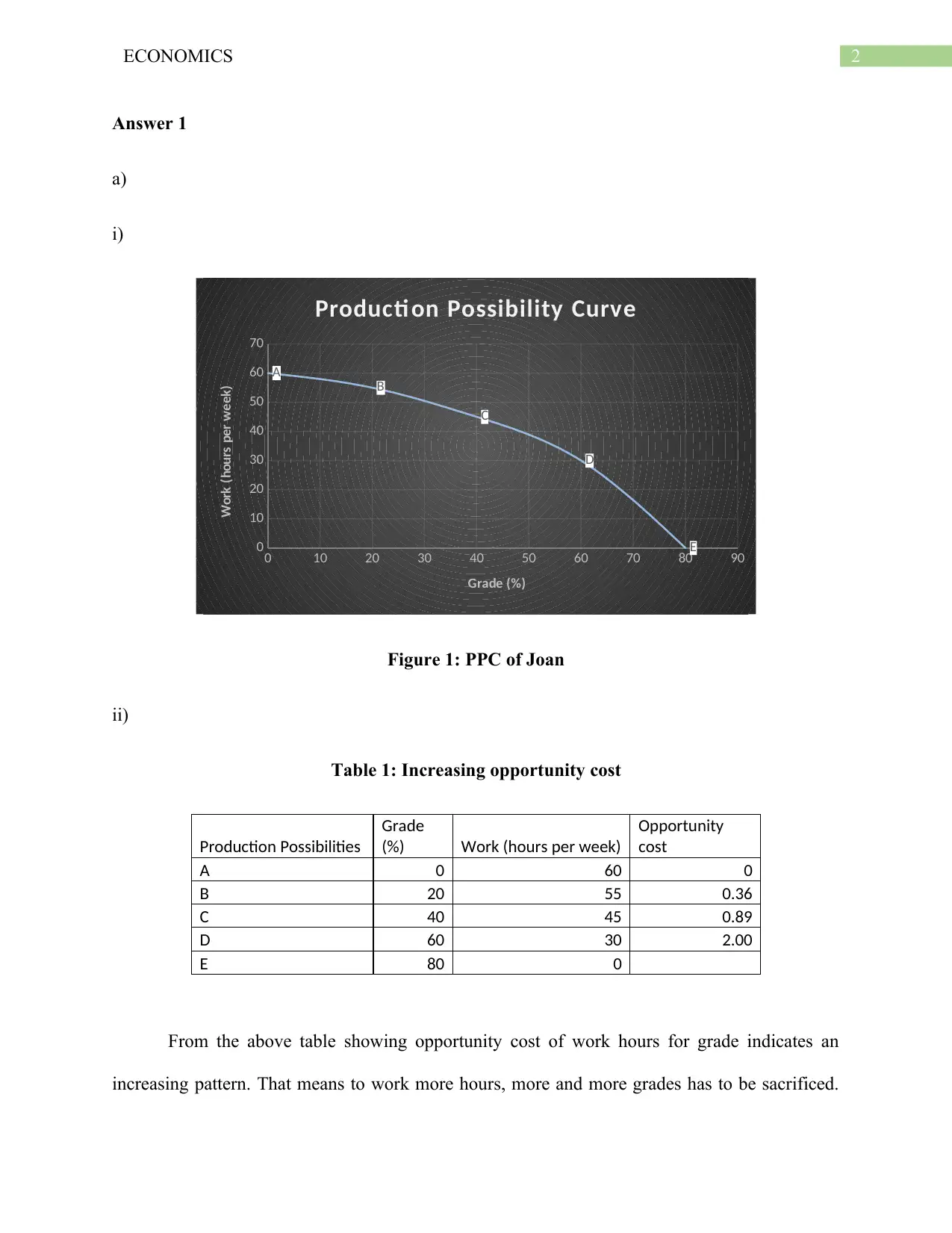
2ECONOMICS
Answer 1
a)
i)
0 10 20 30 40 50 60 70 80 90
0
10
20
30
40
50
60
70
A
B
C
D
E
Producti on Possibility Curve
Grade (%)
Work (hours per week)
Figure 1: PPC of Joan
ii)
Table 1: Increasing opportunity cost
Production Possibilities
Grade
(%) Work (hours per week)
Opportunity
cost
A 0 60 0
B 20 55 0.36
C 40 45 0.89
D 60 30 2.00
E 80 0
From the above table showing opportunity cost of work hours for grade indicates an
increasing pattern. That means to work more hours, more and more grades has to be sacrificed.
Answer 1
a)
i)
0 10 20 30 40 50 60 70 80 90
0
10
20
30
40
50
60
70
A
B
C
D
E
Producti on Possibility Curve
Grade (%)
Work (hours per week)
Figure 1: PPC of Joan
ii)
Table 1: Increasing opportunity cost
Production Possibilities
Grade
(%) Work (hours per week)
Opportunity
cost
A 0 60 0
B 20 55 0.36
C 40 45 0.89
D 60 30 2.00
E 80 0
From the above table showing opportunity cost of work hours for grade indicates an
increasing pattern. That means to work more hours, more and more grades has to be sacrificed.
⊘ This is a preview!⊘
Do you want full access?
Subscribe today to unlock all pages.

Trusted by 1+ million students worldwide
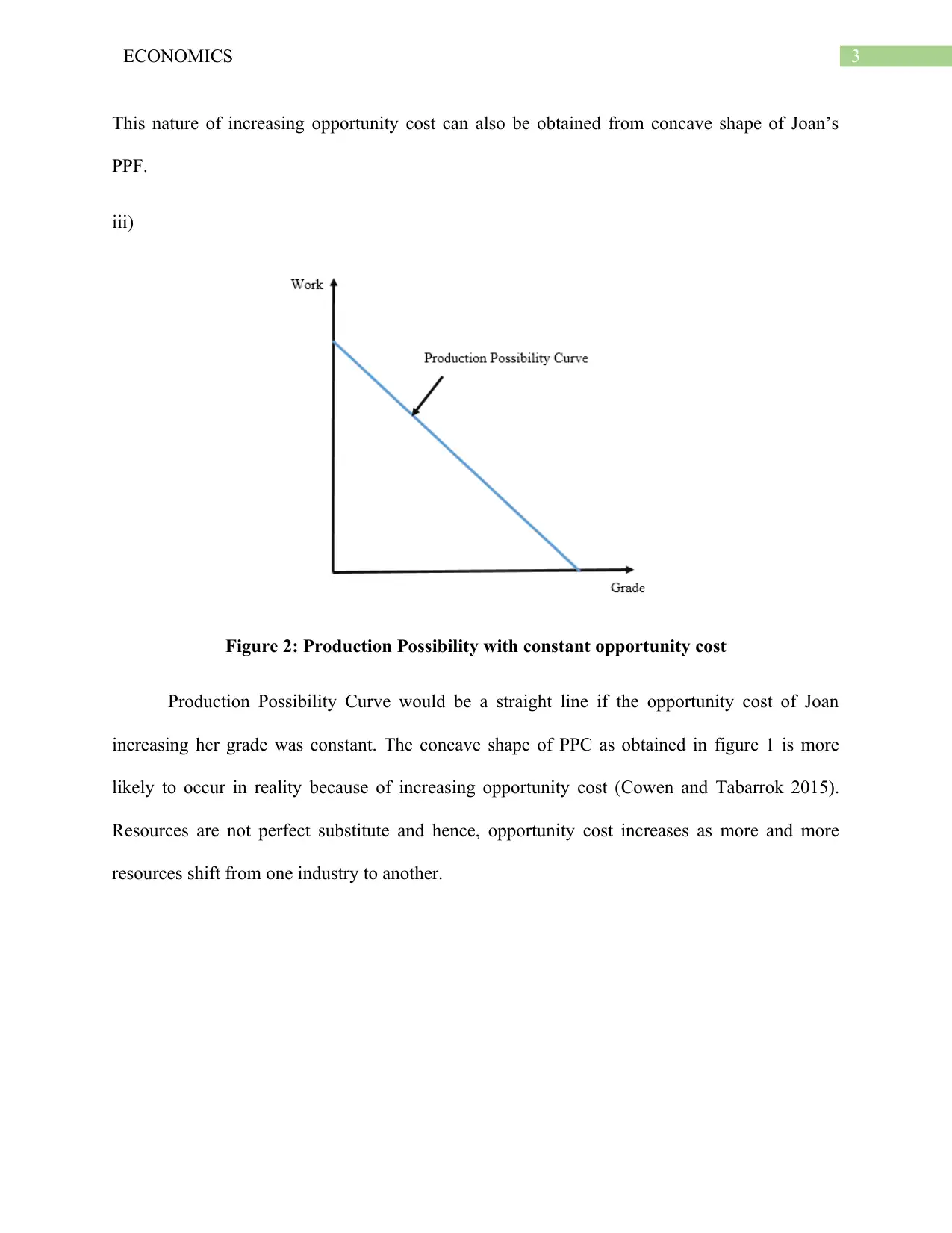
3ECONOMICS
This nature of increasing opportunity cost can also be obtained from concave shape of Joan’s
PPF.
iii)
Figure 2: Production Possibility with constant opportunity cost
Production Possibility Curve would be a straight line if the opportunity cost of Joan
increasing her grade was constant. The concave shape of PPC as obtained in figure 1 is more
likely to occur in reality because of increasing opportunity cost (Cowen and Tabarrok 2015).
Resources are not perfect substitute and hence, opportunity cost increases as more and more
resources shift from one industry to another.
This nature of increasing opportunity cost can also be obtained from concave shape of Joan’s
PPF.
iii)
Figure 2: Production Possibility with constant opportunity cost
Production Possibility Curve would be a straight line if the opportunity cost of Joan
increasing her grade was constant. The concave shape of PPC as obtained in figure 1 is more
likely to occur in reality because of increasing opportunity cost (Cowen and Tabarrok 2015).
Resources are not perfect substitute and hence, opportunity cost increases as more and more
resources shift from one industry to another.
Paraphrase This Document
Need a fresh take? Get an instant paraphrase of this document with our AI Paraphraser
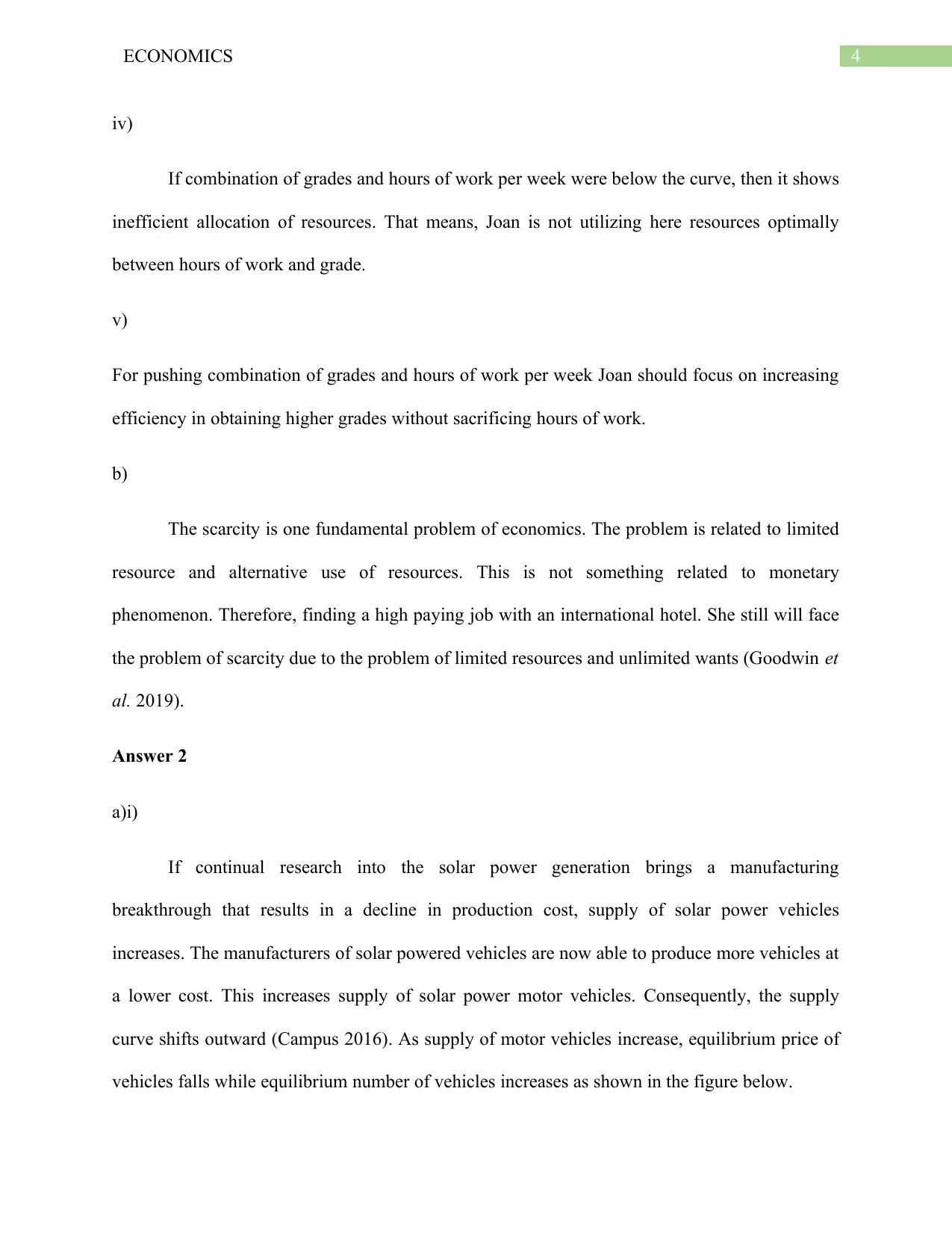
4ECONOMICS
iv)
If combination of grades and hours of work per week were below the curve, then it shows
inefficient allocation of resources. That means, Joan is not utilizing here resources optimally
between hours of work and grade.
v)
For pushing combination of grades and hours of work per week Joan should focus on increasing
efficiency in obtaining higher grades without sacrificing hours of work.
b)
The scarcity is one fundamental problem of economics. The problem is related to limited
resource and alternative use of resources. This is not something related to monetary
phenomenon. Therefore, finding a high paying job with an international hotel. She still will face
the problem of scarcity due to the problem of limited resources and unlimited wants (Goodwin et
al. 2019).
Answer 2
a)i)
If continual research into the solar power generation brings a manufacturing
breakthrough that results in a decline in production cost, supply of solar power vehicles
increases. The manufacturers of solar powered vehicles are now able to produce more vehicles at
a lower cost. This increases supply of solar power motor vehicles. Consequently, the supply
curve shifts outward (Campus 2016). As supply of motor vehicles increase, equilibrium price of
vehicles falls while equilibrium number of vehicles increases as shown in the figure below.
iv)
If combination of grades and hours of work per week were below the curve, then it shows
inefficient allocation of resources. That means, Joan is not utilizing here resources optimally
between hours of work and grade.
v)
For pushing combination of grades and hours of work per week Joan should focus on increasing
efficiency in obtaining higher grades without sacrificing hours of work.
b)
The scarcity is one fundamental problem of economics. The problem is related to limited
resource and alternative use of resources. This is not something related to monetary
phenomenon. Therefore, finding a high paying job with an international hotel. She still will face
the problem of scarcity due to the problem of limited resources and unlimited wants (Goodwin et
al. 2019).
Answer 2
a)i)
If continual research into the solar power generation brings a manufacturing
breakthrough that results in a decline in production cost, supply of solar power vehicles
increases. The manufacturers of solar powered vehicles are now able to produce more vehicles at
a lower cost. This increases supply of solar power motor vehicles. Consequently, the supply
curve shifts outward (Campus 2016). As supply of motor vehicles increase, equilibrium price of
vehicles falls while equilibrium number of vehicles increases as shown in the figure below.
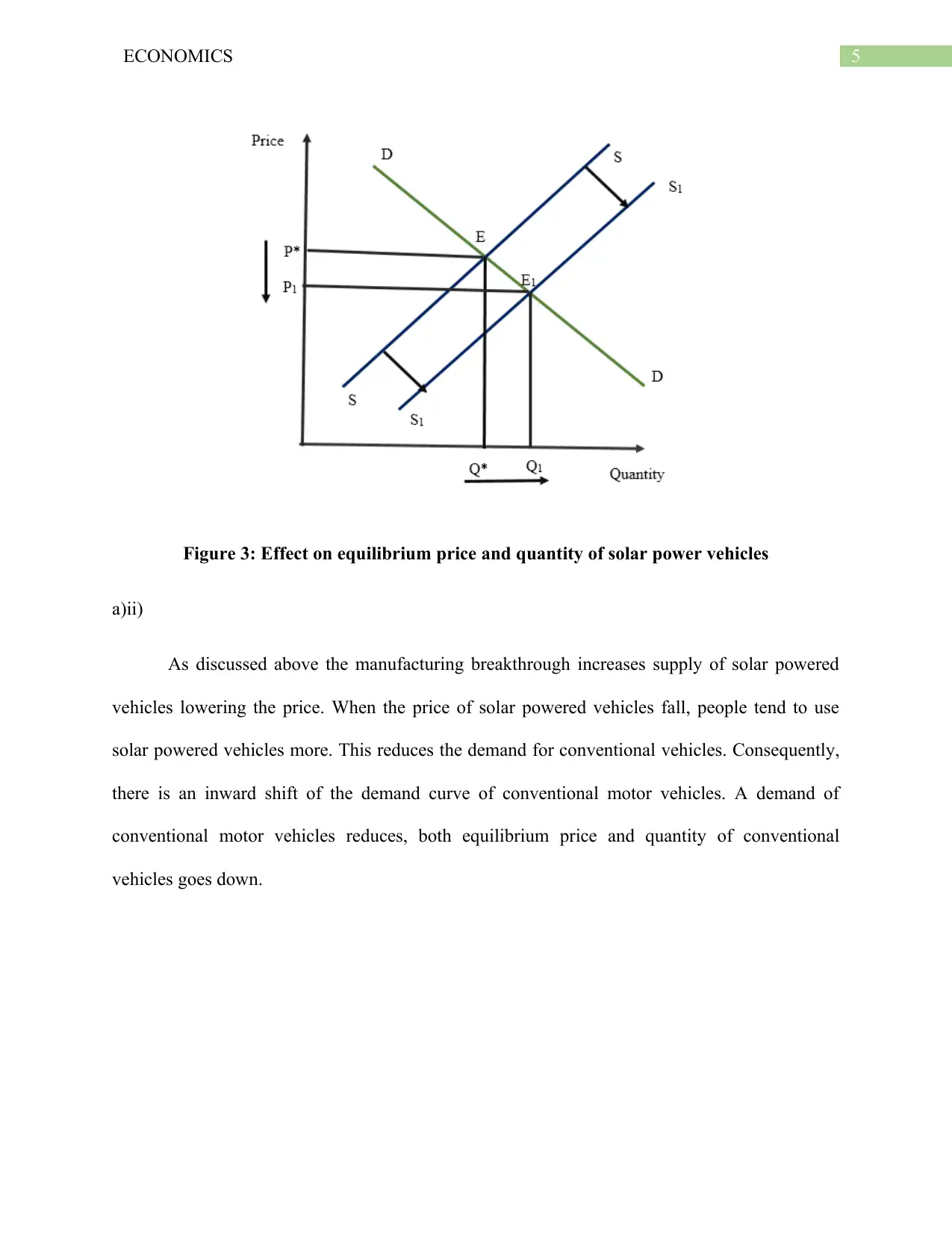
5ECONOMICS
Figure 3: Effect on equilibrium price and quantity of solar power vehicles
a)ii)
As discussed above the manufacturing breakthrough increases supply of solar powered
vehicles lowering the price. When the price of solar powered vehicles fall, people tend to use
solar powered vehicles more. This reduces the demand for conventional vehicles. Consequently,
there is an inward shift of the demand curve of conventional motor vehicles. A demand of
conventional motor vehicles reduces, both equilibrium price and quantity of conventional
vehicles goes down.
Figure 3: Effect on equilibrium price and quantity of solar power vehicles
a)ii)
As discussed above the manufacturing breakthrough increases supply of solar powered
vehicles lowering the price. When the price of solar powered vehicles fall, people tend to use
solar powered vehicles more. This reduces the demand for conventional vehicles. Consequently,
there is an inward shift of the demand curve of conventional motor vehicles. A demand of
conventional motor vehicles reduces, both equilibrium price and quantity of conventional
vehicles goes down.
⊘ This is a preview!⊘
Do you want full access?
Subscribe today to unlock all pages.

Trusted by 1+ million students worldwide
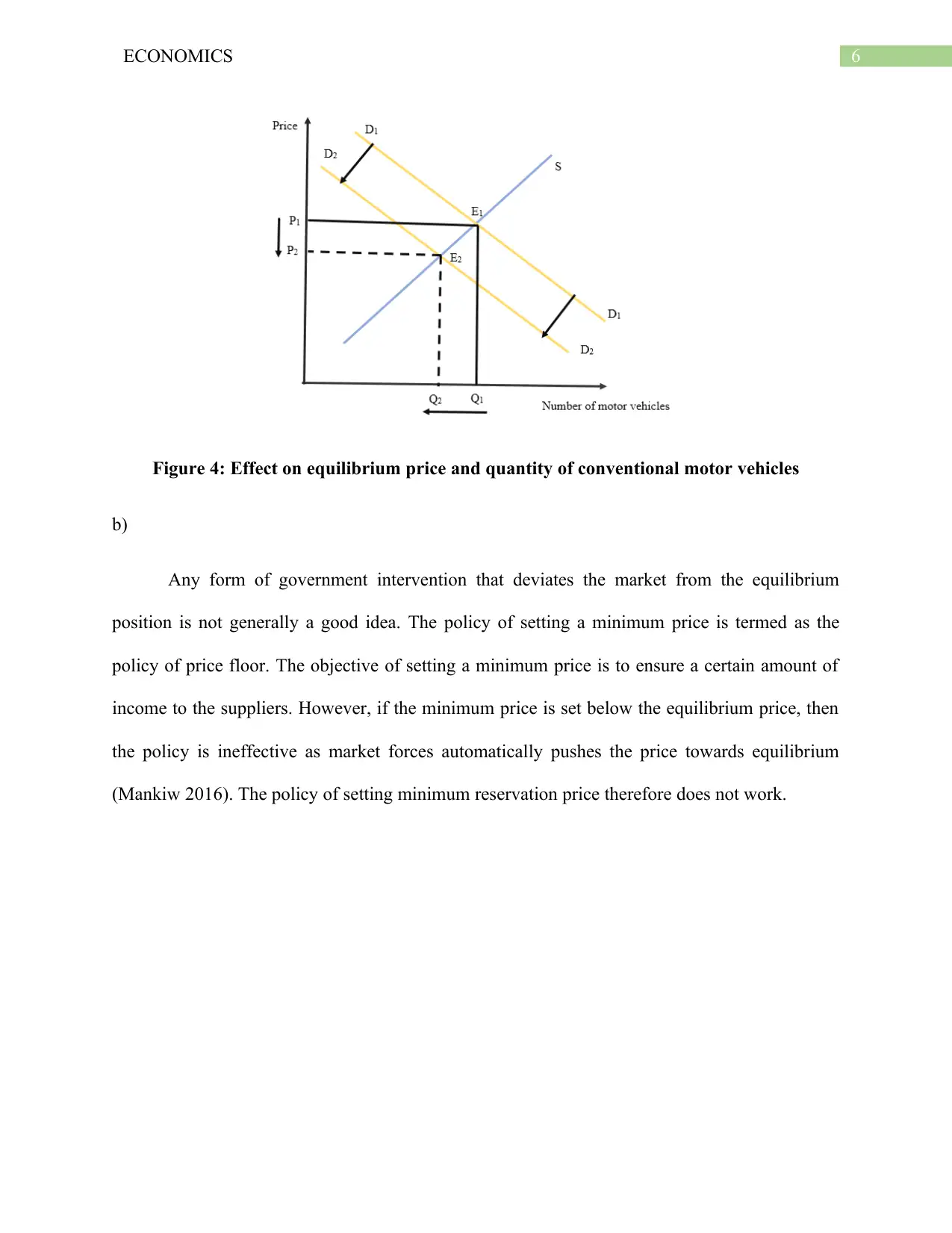
6ECONOMICS
Figure 4: Effect on equilibrium price and quantity of conventional motor vehicles
b)
Any form of government intervention that deviates the market from the equilibrium
position is not generally a good idea. The policy of setting a minimum price is termed as the
policy of price floor. The objective of setting a minimum price is to ensure a certain amount of
income to the suppliers. However, if the minimum price is set below the equilibrium price, then
the policy is ineffective as market forces automatically pushes the price towards equilibrium
(Mankiw 2016). The policy of setting minimum reservation price therefore does not work.
Figure 4: Effect on equilibrium price and quantity of conventional motor vehicles
b)
Any form of government intervention that deviates the market from the equilibrium
position is not generally a good idea. The policy of setting a minimum price is termed as the
policy of price floor. The objective of setting a minimum price is to ensure a certain amount of
income to the suppliers. However, if the minimum price is set below the equilibrium price, then
the policy is ineffective as market forces automatically pushes the price towards equilibrium
(Mankiw 2016). The policy of setting minimum reservation price therefore does not work.
Paraphrase This Document
Need a fresh take? Get an instant paraphrase of this document with our AI Paraphraser
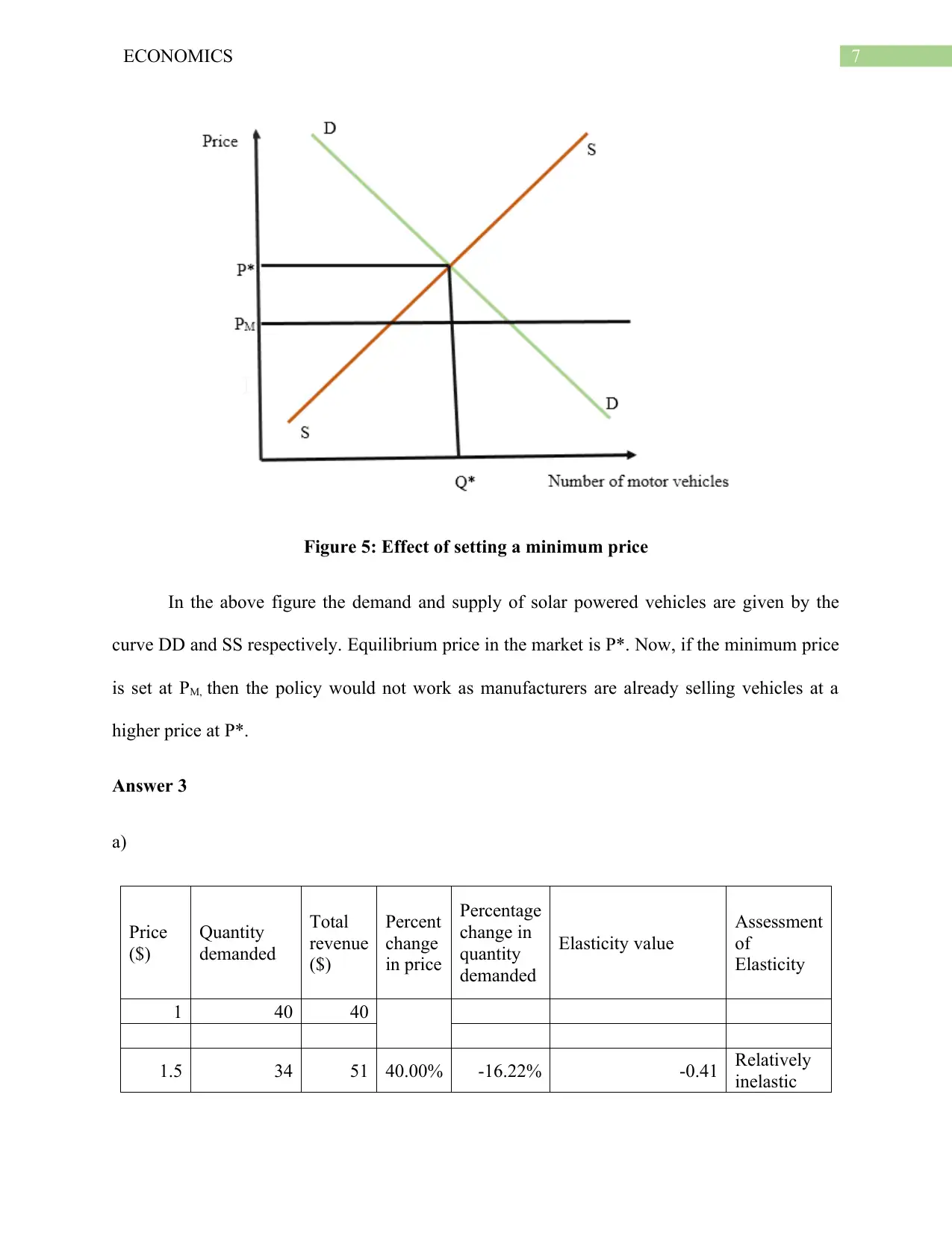
7ECONOMICS
Figure 5: Effect of setting a minimum price
In the above figure the demand and supply of solar powered vehicles are given by the
curve DD and SS respectively. Equilibrium price in the market is P*. Now, if the minimum price
is set at PM, then the policy would not work as manufacturers are already selling vehicles at a
higher price at P*.
Answer 3
a)
Price
($)
Quantity
demanded
Total
revenue
($)
Percent
change
in price
Percentage
change in
quantity
demanded
Elasticity value
Assessment
of
Elasticity
1 40 40
1.5 34 51 40.00% -16.22% -0.41 Relatively
inelastic
Figure 5: Effect of setting a minimum price
In the above figure the demand and supply of solar powered vehicles are given by the
curve DD and SS respectively. Equilibrium price in the market is P*. Now, if the minimum price
is set at PM, then the policy would not work as manufacturers are already selling vehicles at a
higher price at P*.
Answer 3
a)
Price
($)
Quantity
demanded
Total
revenue
($)
Percent
change
in price
Percentage
change in
quantity
demanded
Elasticity value
Assessment
of
Elasticity
1 40 40
1.5 34 51 40.00% -16.22% -0.41 Relatively
inelastic
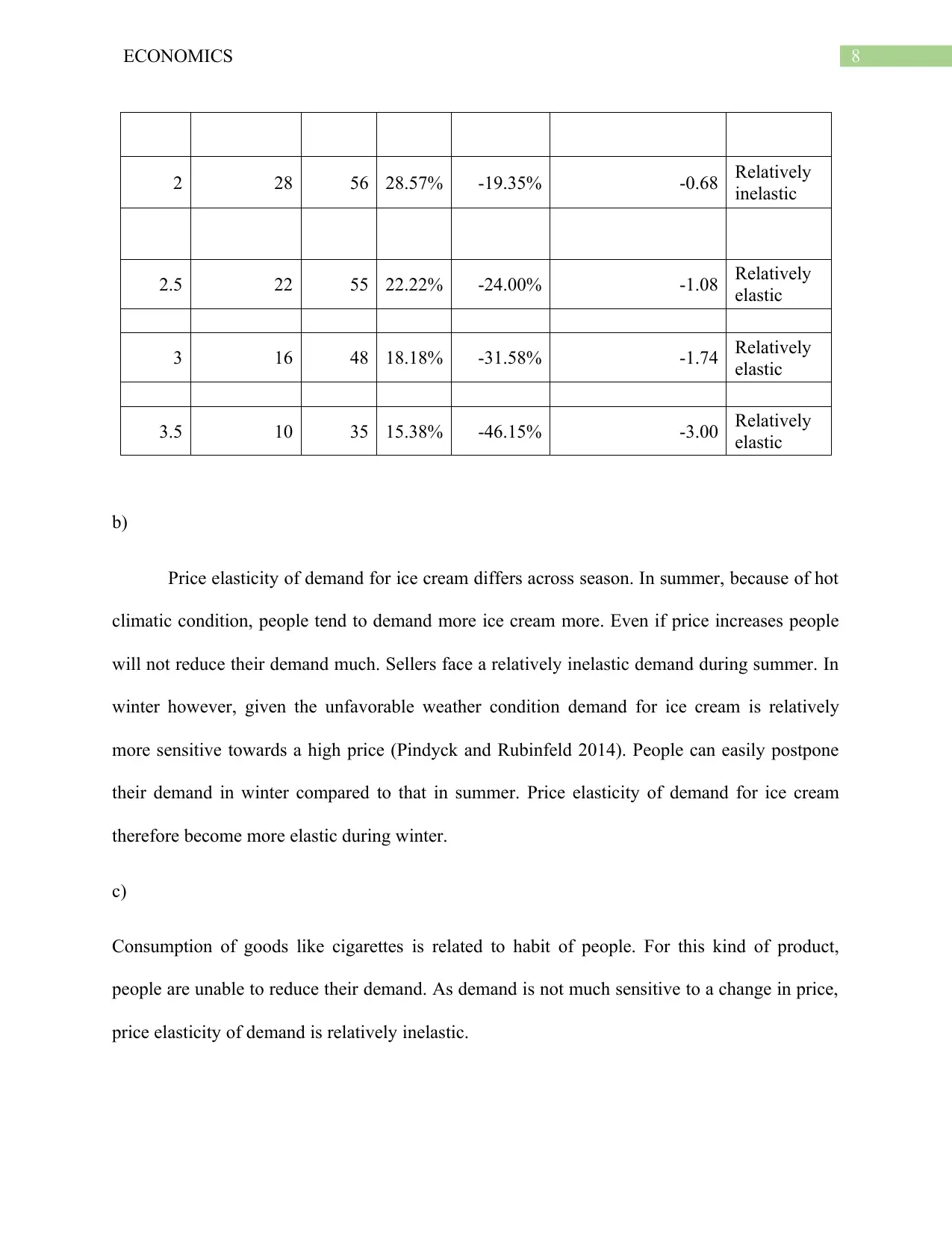
8ECONOMICS
2 28 56 28.57% -19.35% -0.68 Relatively
inelastic
2.5 22 55 22.22% -24.00% -1.08 Relatively
elastic
3 16 48 18.18% -31.58% -1.74 Relatively
elastic
3.5 10 35 15.38% -46.15% -3.00 Relatively
elastic
b)
Price elasticity of demand for ice cream differs across season. In summer, because of hot
climatic condition, people tend to demand more ice cream more. Even if price increases people
will not reduce their demand much. Sellers face a relatively inelastic demand during summer. In
winter however, given the unfavorable weather condition demand for ice cream is relatively
more sensitive towards a high price (Pindyck and Rubinfeld 2014). People can easily postpone
their demand in winter compared to that in summer. Price elasticity of demand for ice cream
therefore become more elastic during winter.
c)
Consumption of goods like cigarettes is related to habit of people. For this kind of product,
people are unable to reduce their demand. As demand is not much sensitive to a change in price,
price elasticity of demand is relatively inelastic.
2 28 56 28.57% -19.35% -0.68 Relatively
inelastic
2.5 22 55 22.22% -24.00% -1.08 Relatively
elastic
3 16 48 18.18% -31.58% -1.74 Relatively
elastic
3.5 10 35 15.38% -46.15% -3.00 Relatively
elastic
b)
Price elasticity of demand for ice cream differs across season. In summer, because of hot
climatic condition, people tend to demand more ice cream more. Even if price increases people
will not reduce their demand much. Sellers face a relatively inelastic demand during summer. In
winter however, given the unfavorable weather condition demand for ice cream is relatively
more sensitive towards a high price (Pindyck and Rubinfeld 2014). People can easily postpone
their demand in winter compared to that in summer. Price elasticity of demand for ice cream
therefore become more elastic during winter.
c)
Consumption of goods like cigarettes is related to habit of people. For this kind of product,
people are unable to reduce their demand. As demand is not much sensitive to a change in price,
price elasticity of demand is relatively inelastic.
⊘ This is a preview!⊘
Do you want full access?
Subscribe today to unlock all pages.

Trusted by 1+ million students worldwide
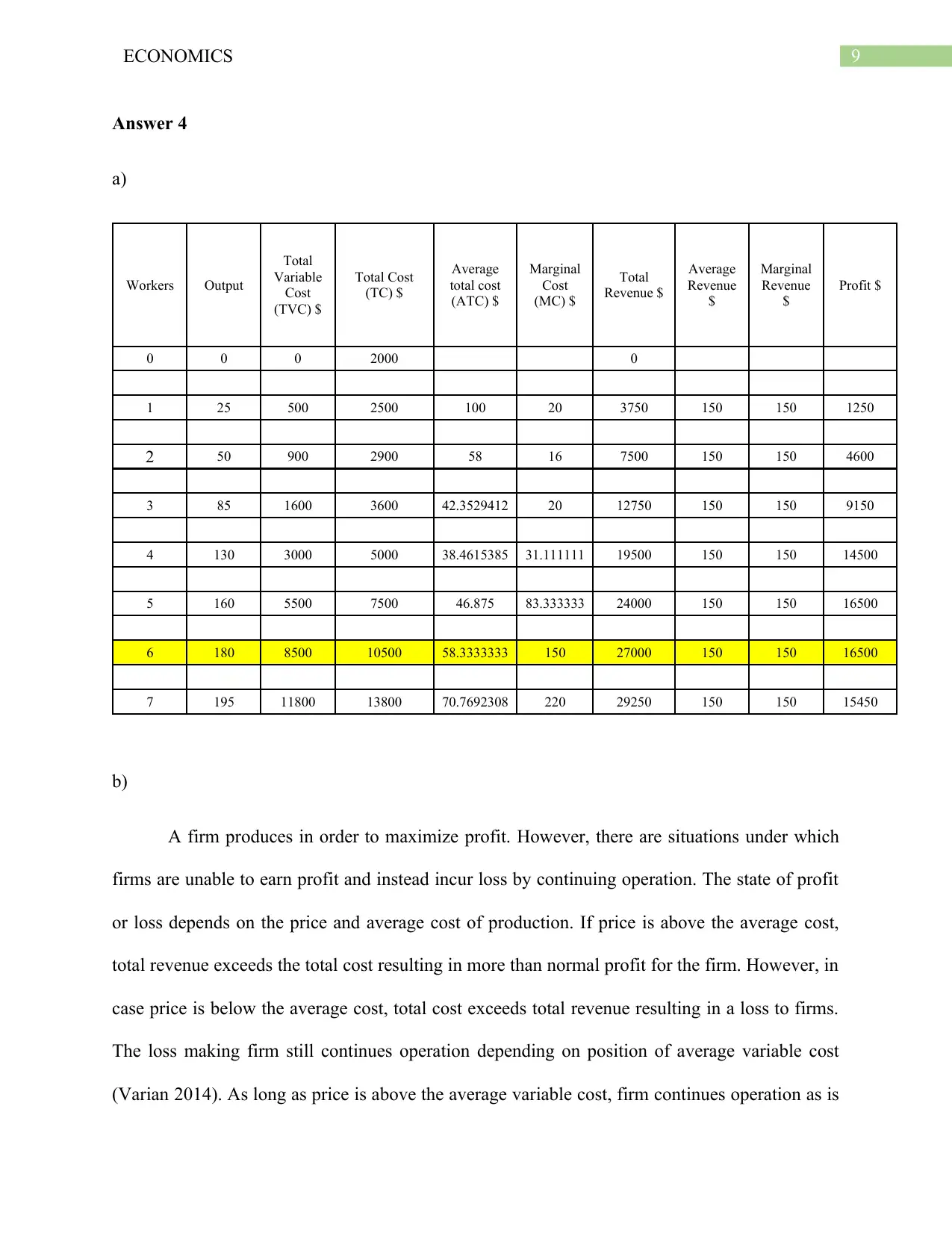
9ECONOMICS
Answer 4
a)
Workers Output
Total
Variable
Cost
(TVC) $
Total Cost
(TC) $
Average
total cost
(ATC) $
Marginal
Cost
(MC) $
Total
Revenue $
Average
Revenue
$
Marginal
Revenue
$
Profit $
0 0 0 2000 0
1 25 500 2500 100 20 3750 150 150 1250
2 50 900 2900 58 16 7500 150 150 4600
3 85 1600 3600 42.3529412 20 12750 150 150 9150
4 130 3000 5000 38.4615385 31.111111 19500 150 150 14500
5 160 5500 7500 46.875 83.333333 24000 150 150 16500
6 180 8500 10500 58.3333333 150 27000 150 150 16500
7 195 11800 13800 70.7692308 220 29250 150 150 15450
b)
A firm produces in order to maximize profit. However, there are situations under which
firms are unable to earn profit and instead incur loss by continuing operation. The state of profit
or loss depends on the price and average cost of production. If price is above the average cost,
total revenue exceeds the total cost resulting in more than normal profit for the firm. However, in
case price is below the average cost, total cost exceeds total revenue resulting in a loss to firms.
The loss making firm still continues operation depending on position of average variable cost
(Varian 2014). As long as price is above the average variable cost, firm continues operation as is
Answer 4
a)
Workers Output
Total
Variable
Cost
(TVC) $
Total Cost
(TC) $
Average
total cost
(ATC) $
Marginal
Cost
(MC) $
Total
Revenue $
Average
Revenue
$
Marginal
Revenue
$
Profit $
0 0 0 2000 0
1 25 500 2500 100 20 3750 150 150 1250
2 50 900 2900 58 16 7500 150 150 4600
3 85 1600 3600 42.3529412 20 12750 150 150 9150
4 130 3000 5000 38.4615385 31.111111 19500 150 150 14500
5 160 5500 7500 46.875 83.333333 24000 150 150 16500
6 180 8500 10500 58.3333333 150 27000 150 150 16500
7 195 11800 13800 70.7692308 220 29250 150 150 15450
b)
A firm produces in order to maximize profit. However, there are situations under which
firms are unable to earn profit and instead incur loss by continuing operation. The state of profit
or loss depends on the price and average cost of production. If price is above the average cost,
total revenue exceeds the total cost resulting in more than normal profit for the firm. However, in
case price is below the average cost, total cost exceeds total revenue resulting in a loss to firms.
The loss making firm still continues operation depending on position of average variable cost
(Varian 2014). As long as price is above the average variable cost, firm continues operation as is
Paraphrase This Document
Need a fresh take? Get an instant paraphrase of this document with our AI Paraphraser
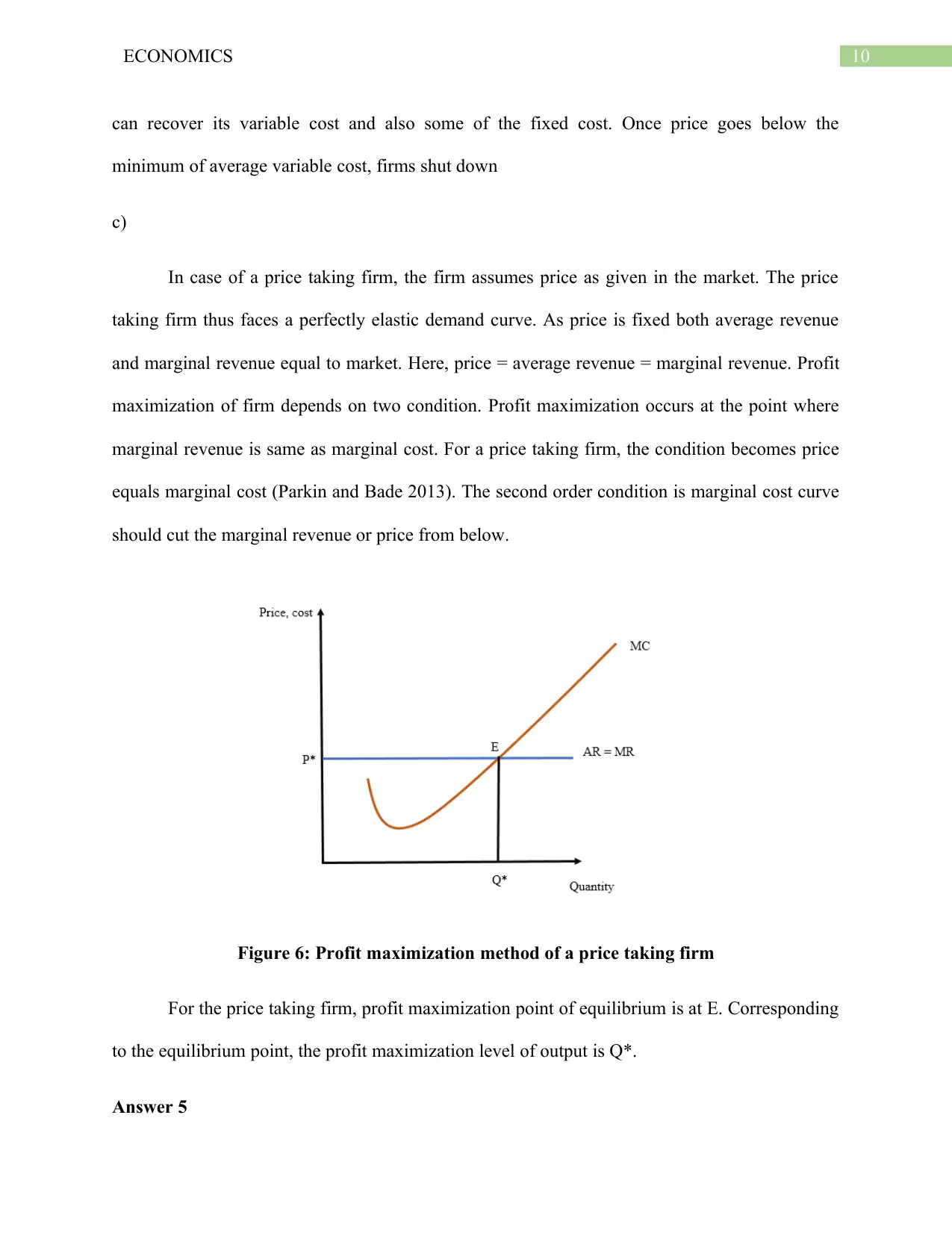
10ECONOMICS
can recover its variable cost and also some of the fixed cost. Once price goes below the
minimum of average variable cost, firms shut down
c)
In case of a price taking firm, the firm assumes price as given in the market. The price
taking firm thus faces a perfectly elastic demand curve. As price is fixed both average revenue
and marginal revenue equal to market. Here, price = average revenue = marginal revenue. Profit
maximization of firm depends on two condition. Profit maximization occurs at the point where
marginal revenue is same as marginal cost. For a price taking firm, the condition becomes price
equals marginal cost (Parkin and Bade 2013). The second order condition is marginal cost curve
should cut the marginal revenue or price from below.
Figure 6: Profit maximization method of a price taking firm
For the price taking firm, profit maximization point of equilibrium is at E. Corresponding
to the equilibrium point, the profit maximization level of output is Q*.
Answer 5
can recover its variable cost and also some of the fixed cost. Once price goes below the
minimum of average variable cost, firms shut down
c)
In case of a price taking firm, the firm assumes price as given in the market. The price
taking firm thus faces a perfectly elastic demand curve. As price is fixed both average revenue
and marginal revenue equal to market. Here, price = average revenue = marginal revenue. Profit
maximization of firm depends on two condition. Profit maximization occurs at the point where
marginal revenue is same as marginal cost. For a price taking firm, the condition becomes price
equals marginal cost (Parkin and Bade 2013). The second order condition is marginal cost curve
should cut the marginal revenue or price from below.
Figure 6: Profit maximization method of a price taking firm
For the price taking firm, profit maximization point of equilibrium is at E. Corresponding
to the equilibrium point, the profit maximization level of output is Q*.
Answer 5
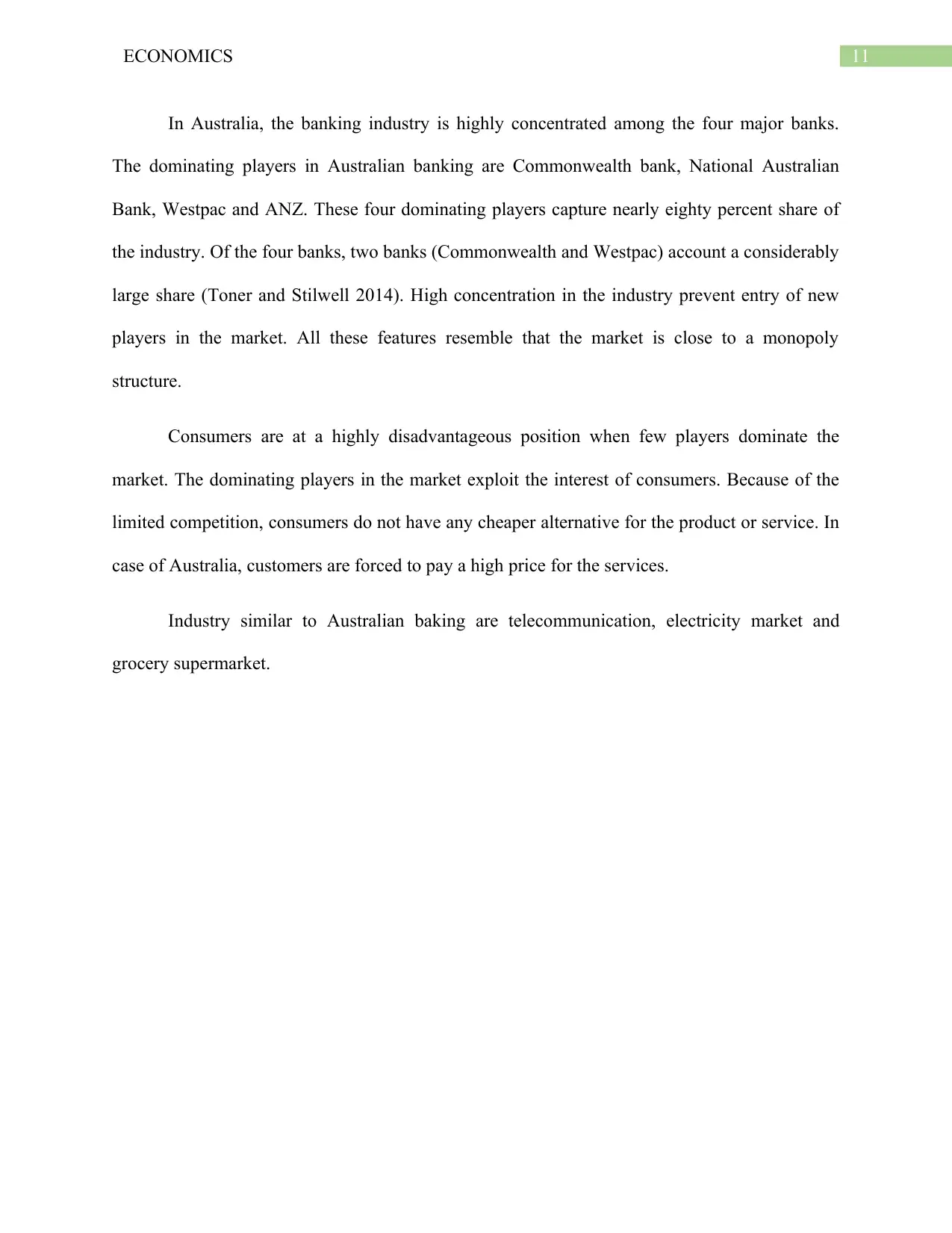
11ECONOMICS
In Australia, the banking industry is highly concentrated among the four major banks.
The dominating players in Australian banking are Commonwealth bank, National Australian
Bank, Westpac and ANZ. These four dominating players capture nearly eighty percent share of
the industry. Of the four banks, two banks (Commonwealth and Westpac) account a considerably
large share (Toner and Stilwell 2014). High concentration in the industry prevent entry of new
players in the market. All these features resemble that the market is close to a monopoly
structure.
Consumers are at a highly disadvantageous position when few players dominate the
market. The dominating players in the market exploit the interest of consumers. Because of the
limited competition, consumers do not have any cheaper alternative for the product or service. In
case of Australia, customers are forced to pay a high price for the services.
Industry similar to Australian baking are telecommunication, electricity market and
grocery supermarket.
In Australia, the banking industry is highly concentrated among the four major banks.
The dominating players in Australian banking are Commonwealth bank, National Australian
Bank, Westpac and ANZ. These four dominating players capture nearly eighty percent share of
the industry. Of the four banks, two banks (Commonwealth and Westpac) account a considerably
large share (Toner and Stilwell 2014). High concentration in the industry prevent entry of new
players in the market. All these features resemble that the market is close to a monopoly
structure.
Consumers are at a highly disadvantageous position when few players dominate the
market. The dominating players in the market exploit the interest of consumers. Because of the
limited competition, consumers do not have any cheaper alternative for the product or service. In
case of Australia, customers are forced to pay a high price for the services.
Industry similar to Australian baking are telecommunication, electricity market and
grocery supermarket.
⊘ This is a preview!⊘
Do you want full access?
Subscribe today to unlock all pages.

Trusted by 1+ million students worldwide
1 out of 13
Related Documents
Your All-in-One AI-Powered Toolkit for Academic Success.
+13062052269
info@desklib.com
Available 24*7 on WhatsApp / Email
![[object Object]](/_next/static/media/star-bottom.7253800d.svg)
Unlock your academic potential
Copyright © 2020–2025 A2Z Services. All Rights Reserved. Developed and managed by ZUCOL.





